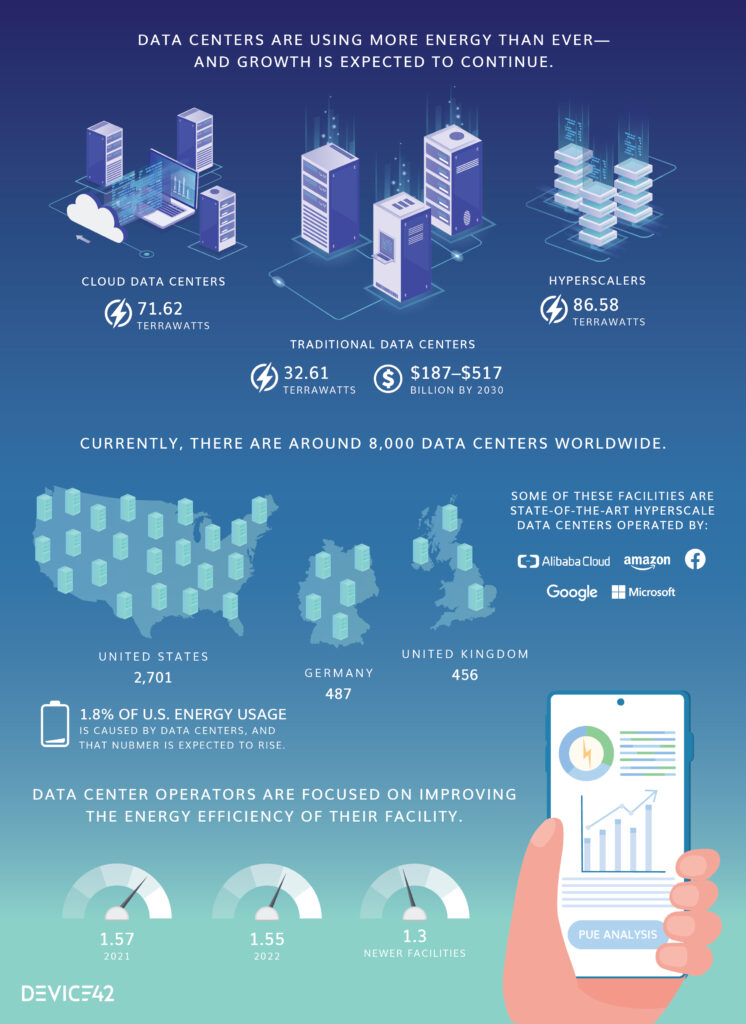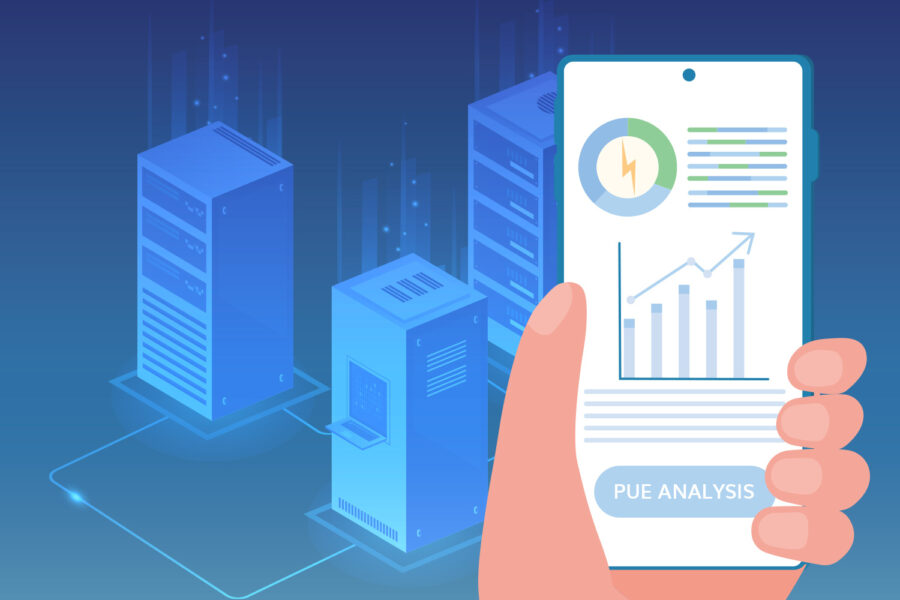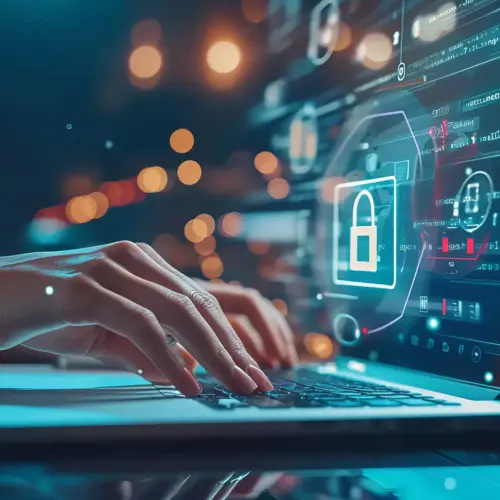Recent events have shown a brighter spotlight on the issue of data center energy efficiency. Geopolitical developments, energy shortages, and rising costs are causing data center owners and operators to redouble their efforts to reduce energy use. In this effort, they’re driven by the desire to reduce costs and operate a more sustainable business.
Due to the fast pace of digitization, data centers are using more energy than ever — and growth is expected to continue. In 2021, traditional data centers used 32.61 terawatt hours of energy, while cloud ones used 71.62 and hyperscalers used 86.58. However, the data center market is slated to triple this decade, growing from $187 billion in 2020 to $517 billion by 2030. As a result, regulators are increasing pressure on data center owners and operators to develop more energy-efficient operations in the near-term.
Currently, there are around 8,000 data centers worldwide. The US is by far the world leader: owning and operating 2,701 facilities, ahead of Germany (487), the UK (456), and China. Some of these facilities are state-of-the hyperscale data centers operated by companies such as Alibaba, Amazon, Facebook, Google, Microsoft or colocation providers. Others are smaller-scale facilities run by enterprises and managed service providers, which may lack the state-of-the-art IT, power, and cooling technology hyperscalers possess.
As they deploy new capacity — or seek to optimize what they have — operators are totally focused on improving power usage effectiveness (PUE), or the energy efficiency of their facility. According to the Uptime Institute, PUE and power consumption are among the industry’s most-tracked sustainability metrics. In 2022, the average annual PUE reported by data centers was 1.55, an incremental reduction from 2021, when it was 1.57. However, newer-build facilities are able to achieve PUEs of 1.3 — or even lower.

What Makes a Data Center Energy-Efficient?
Data centers can vary in their efficiency, depending on several factors. These factors include:
- The size, location, and fabrication of the facility
- The efficiency of the servers and their virtualization density
- The number, type, status, and age of IT equipment being used
- Energy used (fossil fuels versus hybrid energy sources)
- The type of cooling used (air, liquid, etc.)
- The efficiency of the cooling and power systems

Estimated Data Center Power Use in 20222
Based on their calculated average PUE of 1.57, this Gartner graphic depicts how power is used by data center technology.
Getting Ready for the Coming Carbon Tax
Currently, data center owners are pursuing voluntary measures to reduce carbon emissions. For example, the European Union has published a Code of Conduct for Energy Efficiency in Data Centres. However, a carbon tax is surely coming. Since these taxes typically penalize emissions, companies that adopt hybrid energy schemes and use technology to increase use of renewables will pay less or avoid these taxes.
“Gartner: 92% of U.S. data center operators are expecting to pay a carbon tax within the next three years.”
A Three-Point Plan for Reducing Data Center Energy Costs
As they strategize how best to prepare for increased sustainability legislation, data center operators can take some simple steps right now to optimize their operations. Moving forward now will not only ease the strain of regulatory compliance, but reduce energy use and costs in the near-term.
Here’s a potential three-part strategy for moving forward:
- Increase visibility into devices and systems – Data center team members may still be tracking hardware, software, and virtualized assets on spreadsheets. Yet, this information is static, may be missing critical details, and is quickly outdated. A recent survey by Device42 found that 50% of the data center operators don’t even know what type of equipment they have, meaning that there is significant room for improvement.
Data center operators can gain immediate advantages by deploying a next-generation Device42 configuration management database with integrated IT asset management capabilities. The Device42 solution will auto-discover all resources, map dependencies between devices and the applications they support, and track all configurations and changes. As a result, data center teams will gain holistic visibility into the assets they support, including their condition, lifespan, and total cost of ownership. - Deploy more energy-efficient equipment – With greater visibility, teams can now analyze equipment, developing a plan for improving energy efficiency. This process typically involves auditing all assets, understanding their power consumption, stack-ranking inefficiencies, and planning for upgrades or replacements. Typical strategies in a data center operator’s playbook include virtualizing as much as possible and deploying more energy-efficient cooling and power equipment and servers.
- Accelerating the path to the cloud – In addition to gaining increased flexibility and scalability, migrating more resources to the cloud increases sustainability advantages. Data center owners get to reduce Scope 1 emissions, while also partnering with cloud service providers who are constantly evolving programs to reduce carbon emissions.
However, these decisions must be carefully balanced with business goals, including cost reduction. According to the same Device42 survey, 80% of data center operators believe the cloud is either too expensive now or becoming so. In fact, 20% are planning to roll back their cloud workloads onto a traditional on-prem data center– or have already done so.
Use a CMDB and ITAM Solution to Improve Data Center Efficiency
In today’s capital-constrained environment, leaders are looking to save both Capex and Opex costs. That may mean using existing data centers longer than expected by upgrading equipment to gain new capabilities and reduce energy consumption. Or it may mean planning state-of-the art facilities that use every advantage that advanced technology provides to reduce energy consumption and costs.
By centralizing visibility of all hardware, software, and virtualized assets with an integrated Device42 CMDB and ITAM solution, data center operators gain the information they need to make the best decisions for their organization. That means they can carefully optimize business, operational, financial, and sustainability goals for each facility.
Want to learn more about how you can reduce energy consumption and costs? Sign up for the Device42 weekly live demo to see how this solution could transform critical data center processes, starting today.




